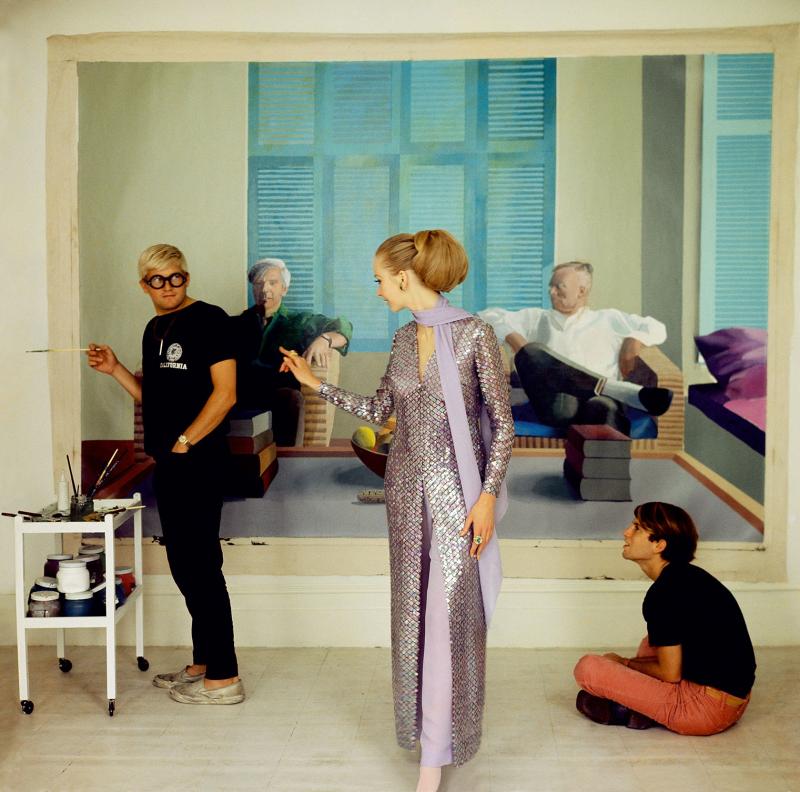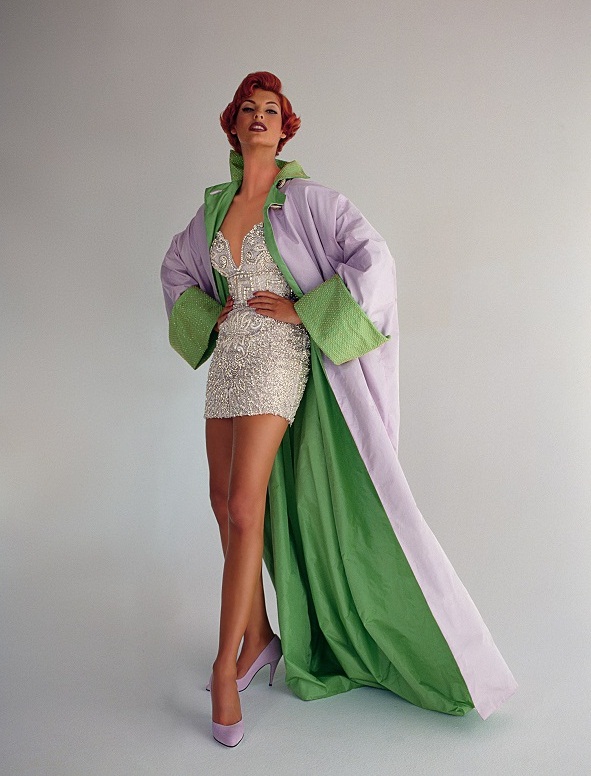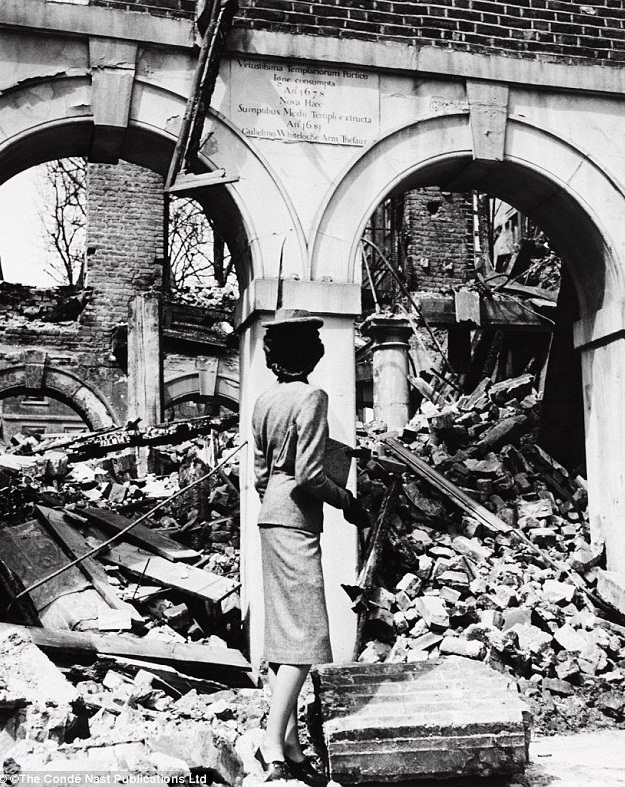Vogue 100, National Portrait Gallery | reviews, news & interviews
Vogue 100, National Portrait Gallery
Vogue 100, National Portrait Gallery
Prepare to be dazzled - a century of images creates the portrait of an age

When it got too hard to ship the original American edition across the Atlantic during the Great War, British Vogue appeared as a sister publication in the Condé Nast empire.
You can match your own feel for history decade by decade against Vogue’s sharp characterisations, with Vogue 100: A Century of Style arranged chronologically from the initial drawings before photography invaded the publication, through early vintage photographs, and on to the blazing colours of today. There is sequence, too: one issue from every year is displayed, with not only its cover but two pages of layout showing how text and image complemented each other in telling juxtaposition.
As if in cyclic waves, different editors took in culture in the broadest sense
There are certainly surprises: a touching and unpublished photograph of The Beatles in 1964, very mop-headed. Other celebrities in unexpected mode include the Beckhams in twinned black outfits, lying on the floor intertwined in a corridor of the Midland Hotel, Manchester; photographed by Juergen Teller in March 1999, it has a clutch of hotel staff, barricaded behind trolleys of sheets and towels, gazing from a corner.
The rise of the supermodel, and the lust for celebrity are phenomena charted with cool veracity. Here be Naomi, Linda, Christy, Cindy, Natalia, Claudia, to mention only a few. Kate Moss, that surprising chameleon – although always recognisable, even in silhouette – dominates the past three decades. There is a visual essay of David Bailey and the Shrimp, alias Jean Shrimpton. We swing between “Cool Britannia”, aristocratic and élite taste, and street cred as Vogue takes us on a merry-go-round of style, the business of fashion and beauty. There are hints, too, of the importance of editors and stylists, the teams responsible for the journey of idea to publication (Linda Evangelista by Patrick Demarchelier, 1991, pictured below ©The Condé Nast Publications Ltd).
 Sometimes, a whole era is summed up in a single photograph. There is a big blow-up of the young David Hockney (just turned famously blond) in his studio, his lover the young painter Peter Schlesinger cross-legged on the floor, and his masterly double portrait of Christopher Isherwood and Don Bachardy on the wall: turning towards Hockney as though in conversation, is the model Maudie James, in lilac sequins, natch. Hockney’s black T-shirt bears the simple word “California”. Cecil Beaton’s 1968 mage (main picture) is masterly, and this anthology perhaps subtly acclaims him as the quietly dominant figure in Vogue’s history, mixing an (at times) almost uncomfortable passion for royalty, aristocracy and wealth with moments of insight, and an ability to locate the zeitgeist.
Sometimes, a whole era is summed up in a single photograph. There is a big blow-up of the young David Hockney (just turned famously blond) in his studio, his lover the young painter Peter Schlesinger cross-legged on the floor, and his masterly double portrait of Christopher Isherwood and Don Bachardy on the wall: turning towards Hockney as though in conversation, is the model Maudie James, in lilac sequins, natch. Hockney’s black T-shirt bears the simple word “California”. Cecil Beaton’s 1968 mage (main picture) is masterly, and this anthology perhaps subtly acclaims him as the quietly dominant figure in Vogue’s history, mixing an (at times) almost uncomfortable passion for royalty, aristocracy and wealth with moments of insight, and an ability to locate the zeitgeist.
Yes, he captured Wallis Simpson at home in her flat in Regent’s Park in 1936. But he also showed us, with subtle ferocity, a behatted model, properly gloved, wearing a Digby Morton suit, carrying her handbag, her back to us as she gazes at the blitzed ruins of London’s Middle Temple, September 1941. Life – and fashion – goes on, somehow (Fashion Is Indestructible by Cecil Beaton, 1941, pictured below ©The Condé Nast Publications Ltd). An essay by Paul Nash, accompanied by his own paintings and photographs as illustrations, entitled “The Personality of Planes”, is another evocative (if somewhat unlikely) war time effort.
 More to be expected, there is a soupçon of Diana, glimpsed informally on a Happy Birthday cover, and in a photograph by Patrick Demarchelier, December 1990, with her beaming as the Princess of Wales, adorned with tiara. Mrs Thatcher is resplendent in 10 Downing Street, photographed in October 1985 by David Bailey, whose painfully effortful charm is remarked on. The magazine’s horizons spread much further, though: from early on there is an intense 1926 portrait of Aldous Huxley by the avant-garde artist and photographer Charles Sheeler (evidently the author of Brave New World once worked as a sub-editor on Vogue). Sir John Betjeman, almost hysterical with laughter, is photographed by Snowdon, who cut a swath through the intelligentisia, portraying inter alia an infamously sulky Martin Amis, Germaine Greer, and Peter Sellers, all in black and white. The scarily gimlet-eyed Francis Bacon is the work of his fellow Soho habitué, John Deakin.
More to be expected, there is a soupçon of Diana, glimpsed informally on a Happy Birthday cover, and in a photograph by Patrick Demarchelier, December 1990, with her beaming as the Princess of Wales, adorned with tiara. Mrs Thatcher is resplendent in 10 Downing Street, photographed in October 1985 by David Bailey, whose painfully effortful charm is remarked on. The magazine’s horizons spread much further, though: from early on there is an intense 1926 portrait of Aldous Huxley by the avant-garde artist and photographer Charles Sheeler (evidently the author of Brave New World once worked as a sub-editor on Vogue). Sir John Betjeman, almost hysterical with laughter, is photographed by Snowdon, who cut a swath through the intelligentisia, portraying inter alia an infamously sulky Martin Amis, Germaine Greer, and Peter Sellers, all in black and white. The scarily gimlet-eyed Francis Bacon is the work of his fellow Soho habitué, John Deakin.
Over the past century, as if in cyclic waves, different editors took in culture in the broadest sense – beyond fashion per se, through war, conflict, depressions, crises and societal changes. One controversial moment is summed up in a sequence of Kate Moss as London girl wandering around apparently unobserved in a bleak London flat, garbed in the flimsiest of ordinary underwear. The controversial photographs – apparently telling it like it is – are by Corinne Day, from 1993; the photographer noted at the time that Moss was “just this cocky girl from Croydon – but I knew she was going to be famous.” It has been glamour to grunge, that harshly identified “heroin chic” and back again.
 Throughout, black and white is as potent as colour. There are surprisingly tender portraits of the great fashion designers: Christian Dior looks apprehensive, photographed by Clifford Coffin in April 1947, at his first collection that initiated the New Look and marked the end of wartime austerity. He seems simultaneously frightened and confident; Yves St Laurent, his heir, is painfully young, apprehensive and impeccable before his first collection, in the image by Irving Penn from February 1958. You sense that all of the glitterati (and literati, for that matter) are here: it’s an accolade rather like being on Desert Island Discs, a momentous pause to acknowledge seminal influence and talent (Claudia Schiffer in Paris, by Herb Ritts, 1989, pictured above right ©Herb Ritts Foundation/Trunk Archive).
Throughout, black and white is as potent as colour. There are surprisingly tender portraits of the great fashion designers: Christian Dior looks apprehensive, photographed by Clifford Coffin in April 1947, at his first collection that initiated the New Look and marked the end of wartime austerity. He seems simultaneously frightened and confident; Yves St Laurent, his heir, is painfully young, apprehensive and impeccable before his first collection, in the image by Irving Penn from February 1958. You sense that all of the glitterati (and literati, for that matter) are here: it’s an accolade rather like being on Desert Island Discs, a momentous pause to acknowledge seminal influence and talent (Claudia Schiffer in Paris, by Herb Ritts, 1989, pictured above right ©Herb Ritts Foundation/Trunk Archive).
Every picture on the wall here tells its own story. But Vogue also tells the wider story in words too: while the pictures are more immediate, and offer instant access, the captions, dates and quotes are vital components in the display which has been brilliantly choreographed by the theatre designer Patrick Kinmouth. The carefully devised sections mean the visitor is not completely overwhelmed. The selection from countless thousands of images and stories made by guest curator Robin Muir, a Vogue contributing editor and archivist, over a period of six years, is a triumph of compression (the British archive was actually shredded in the war for vitally needed scrap, so the American holdings flesh it out). Vogue 100 is a history of Britain over her past century, told with wit and panache, flamboyance and enthusiasm, elegance and charm. It is a kind of fairytale of course, of beauty and accomplishment, zestfully mediated through the camera lens: escapism – with benefits.
- Vogue 100: A Century of Style at the National Portrait Gallery until 22 May
rating
Explore topics
Share this article
The future of Arts Journalism
You can stop theartsdesk.com closing!
We urgently need financing to survive. Our fundraising drive has thus far raised £33,000 but we need to reach £100,000 or we will be forced to close. Please contribute here: https://gofund.me/c3f6033d
And if you can forward this information to anyone who might assist, we’d be grateful.

Subscribe to theartsdesk.com
Thank you for continuing to read our work on theartsdesk.com. For unlimited access to every article in its entirety, including our archive of more than 15,000 pieces, we're asking for £5 per month or £40 per year. We feel it's a very good deal, and hope you do too.
To take a subscription now simply click here.
And if you're looking for that extra gift for a friend or family member, why not treat them to a theartsdesk.com gift subscription?
more Visual arts
 Help to give theartsdesk a future!
Support our GoFundMe appeal
Help to give theartsdesk a future!
Support our GoFundMe appeal
 Do Ho Suh: Walk the House, Tate Modern review - memories are made of this
Home sweet home preserved as exquisite replicas
Do Ho Suh: Walk the House, Tate Modern review - memories are made of this
Home sweet home preserved as exquisite replicas
 Ed Atkins, Tate Britain review - hiding behind computer generated doppelgängers
Emotions too raw to explore
Ed Atkins, Tate Britain review - hiding behind computer generated doppelgängers
Emotions too raw to explore
 Echoes: Stone Circles, Community and Heritage, Stonehenge Visitor Centre review - young photographers explore ancient resonances
The ancient monument opens its first exhibition of new photography
Echoes: Stone Circles, Community and Heritage, Stonehenge Visitor Centre review - young photographers explore ancient resonances
The ancient monument opens its first exhibition of new photography
 Hylozoic/Desires: Salt Cosmologies, Somerset House and The Hedge of Halomancy, Tate Britain review - the power of white powder
A strong message diluted by space and time
Hylozoic/Desires: Salt Cosmologies, Somerset House and The Hedge of Halomancy, Tate Britain review - the power of white powder
A strong message diluted by space and time
 Mickalene Thomas, All About Love, Hayward Gallery review - all that glitters
The shock of the glue: rhinestones to the ready
Mickalene Thomas, All About Love, Hayward Gallery review - all that glitters
The shock of the glue: rhinestones to the ready
 Interview: Polar photographer Sebastian Copeland talks about the dramatic changes in the Arctic
An ominous shift has come with dark patches appearing on the Greenland ice sheet
Interview: Polar photographer Sebastian Copeland talks about the dramatic changes in the Arctic
An ominous shift has come with dark patches appearing on the Greenland ice sheet
 Donald Rodney: Visceral Canker, Whitechapel Gallery review - absence made powerfully present
Illness as a drive to creativity
Donald Rodney: Visceral Canker, Whitechapel Gallery review - absence made powerfully present
Illness as a drive to creativity
 Noah Davis, Barbican review - the ordinary made strangely compelling
A voice from the margins
Noah Davis, Barbican review - the ordinary made strangely compelling
A voice from the margins
 Best of 2024: Visual Arts
A great year for women artists
Best of 2024: Visual Arts
A great year for women artists
 Electric Dreams: Art and Technology Before the Internet, Tate Modern review - an exhaustive and exhausting show
Flashing lights, beeps and buzzes are diverting, but quickly pall
Electric Dreams: Art and Technology Before the Internet, Tate Modern review - an exhaustive and exhausting show
Flashing lights, beeps and buzzes are diverting, but quickly pall
 ARK: United States V by Laurie Anderson, Aviva Studios, Manchester review - a vessel for the thoughts and imaginings of a lifetime
Despite anticipating disaster, this mesmerising voyage is full of hope
ARK: United States V by Laurie Anderson, Aviva Studios, Manchester review - a vessel for the thoughts and imaginings of a lifetime
Despite anticipating disaster, this mesmerising voyage is full of hope

Add comment